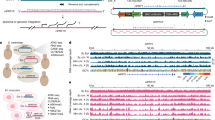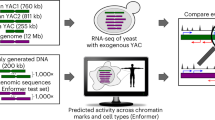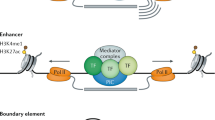Abstract
Eukaryotic transcription occurs within a chromatin environment, whose organization has an important regulatory function and is partly encoded in cis by the DNA sequence itself. Here, we examine whether evolutionary changes in gene expression are linked to changes in the DNA-encoded nucleosome organization of promoters. We find that in aerobic yeast species, where cellular respiration genes are active under typical growth conditions, the promoter sequences of these genes encode a relatively open (nucleosome-depleted) chromatin organization. This nucleosome-depleted organization requires only DNA sequence information, is independent of any cofactors and of transcription, and is a general property of growth-related genes. In contrast, in anaerobic yeast species, where cellular respiration genes are relatively inactive under typical growth conditions, respiration gene promoters encode relatively closed (nucleosome-occupied) chromatin organizations. Our results suggest a previously unidentified genetic mechanism underlying phenotypic diversity, consisting of DNA sequence changes that directly alter the DNA-encoded nucleosome organization of promoters.
This is a preview of subscription content, access via your institution
Access options
Subscribe to this journal
Receive 12 print issues and online access
$209.00 per year
only $17.42 per issue
Buy this article
- Purchase on Springer Link
- Instant access to full article PDF
Prices may be subject to local taxes which are calculated during checkout





Similar content being viewed by others
References
Ihmels, J. et al. Rewiring of the yeast transcriptional network through the evolution of motif usage. Science 309, 938–940 (2005).
Borneman, A.R. et al. Divergence of transcription factor binding sites across related yeast species. Science 317, 815–819 (2007).
Lee, W. et al. A high-resolution atlas of nucleosome occupancy in yeast. Nat. Genet. 39, 1235–1244 (2007).
Yuan, G.C. et al. Genome-scale identification of nucleosome positions in S. cerevisiae. Science 309, 626–630 (2005).
Albert, I. et al. Translational and rotational settings of H2A.Z nucleosomes across the Saccharomyces cerevisiae genome. Nature 446, 572–576 (2007).
Shivaswamy, S. et al. Dynamic remodeling of individual nucleosomes across a eukaryotic genome in response to transcriptional perturbation. PLoS Biol. 6, e65 (2008).
Whitehouse, I., Rando, O.J., Delrow, J. & Tsukiyama, T. Chromatin remodelling at promoters suppresses antisense transcription. Nature 450, 1031–1035 (2007).
Ozsolak, F., Song, J.S., Liu, X.S. & Fisher, D.E. High-throughput mapping of the chromatin structure of human promoters. Nat. Biotechnol. 25, 244–248 (2007).
Mavrich, T.N. et al. A barrier nucleosome model for statistical positioning of nucleosomes throughout the yeast genome. Genome Res 18, 1073–1083 (2008).
Segal, E. et al. A genomic code for nucleosome positioning. Nature 442, 772–778 (2006).
Ioshikhes, I.P., Albert, I., Zanton, S.J. & Pugh, B.F. Nucleosome positions predicted through comparative genomics. Nat. Genet. 38, 1210–1215 (2006).
Peckham, H.E. et al. Nucleosome positioning signals in genomic DNA. Genome Res. 17, 1170–1177 (2007).
Yuan, G.C. & Liu, J.S. Genomic sequence is highly predictive of local nucleosome depletion. PLoS Comput. Biol. 4, e13 (2008).
Wapinski, I., Pfeffer, A., Friedman, N. & Regev, A. Natural history and evolutionary principles of gene duplication in fungi. Nature 449, 54–61 (2007).
Stuart, J.M., Segal, E., Koller, D. & Kim, S.K. A gene-coexpression network for global discovery of conserved genetic modules. Science 302, 249–255 (2003).
Bergmann, S., Ihmels, J. & Barkai, N. Similarities and differences in genome-wide expression data of six organisms. PLoS Biol. 2, E9 (2004).
Ashburner, M. et al. Gene ontology: tool for the unification of biology. The Gene Ontology Consortium. Nat. Genet. 25, 25–29 (2000).
Segal, E., Friedman, N., Koller, D. & Regev, A. A module map showing conditional activity of expression modules in cancer. Nat. Genet. 36, 1090–1098 (2004).
Gasch, A.P. et al. Genomic expression programs in the response of yeast cells to environmental changes. Mol. Biol. Cell 11, 4241–4257 (2000).
Mager, W.H. & Planta, R.J. Coordinate expression of ribosomal protein genes in yeast as a function of cellular growth rate. Mol. Cell. Biochem. 104, 181–187 (1991).
Field, Y. et al. Distinct modes of regulation by chromatin encoded through nucleosome positioning signals. PLoS Comput. Biol. 4, e1000216 (2008).
Hanley, J.A. & McNeil, B.J. The meaning and use of the area under a receiver operating characteristic (ROC) curve. Radiology 143, 29–36 (1982).
Thastrom, A., Bingham, L.M. & Widom, J. Nucleosomal locations of dominant DNA sequence motifs for histone-DNA interactions and nucleosome positioning. J. Mol. Biol. 338, 695–709 (2004).
Kaplan, N. et al. The DNA-encoded nucleosome organization of a eukaryotic genome. Nature advance online publication, doi:10.1038/nature07667 (17 December 2008).
Man, O. & Pilpel, Y. Differential translation efficiency of orthologous genes is involved in phenotypic divergence of yeast species. Nat. Genet. 39, 415–421 (2007).
Piskur, J. & Langkjaer, R.B. Yeast genome sequencing: the power of comparative genomics. Mol. Microbiol. 53, 381–389 (2004).
Feng, H.P., Scherl, D.S. & Widom, J. Lifetime of the histone octamer studied by continuous-flow quasielastic light scattering: test of a model for nucleosome transcription. Biochemistry 32, 7824–7831 (1993).
Altschul, S.F., Gish, W., Miller, W., Myers, E.W. & Lipman, D.J. Basic local alignment search tool. J. Mol. Biol. 215, 403–410 (1990).
Acknowledgements
We acknowledge with gratitude the gift of strains, protocols and advice from J. Berman (University of Minnesota), and thank H. Kelkar (University of North Carolina) for help with the Illumina sequencing data and the members of our respective laboratories for discussions and comments on the manuscript. This work was supported by grants from the US National Institutes of Health to J.D.L., from the NIH to J.W., and from the European Research Council (ERC) and NIH to E.S. N.K. is a Clore scholar. E.S. is the incumbent of the Soretta and Henry Shapiro career development chair.
Author information
Authors and Affiliations
Contributions
Y.F., I.K.M., J.D.L., J.W. and E.S. conceived and designed the experiments. Y.F.-M. and I.K.M. performed the experiments. P.M. performed the sequencing. Y.F., N.K., Y.L., J.D.L., J.W. and E.S. analyzed the data. Y.F., J.D.L., J.W. and E.S. wrote the paper.
Corresponding authors
Supplementary information
Supplementary Text and Figures
Supplementary Figures 1–3 and Supplementary Tables 1 and 2 (PDF 748 kb)
Rights and permissions
About this article
Cite this article
Field, Y., Fondufe-Mittendorf, Y., Moore, I. et al. Gene expression divergence in yeast is coupled to evolution of DNA-encoded nucleosome organization. Nat Genet 41, 438–445 (2009). https://doi.org/10.1038/ng.324
Received:
Accepted:
Published:
Issue Date:
DOI: https://doi.org/10.1038/ng.324
This article is cited by
-
Molecular and evolutionary processes generating variation in gene expression
Nature Reviews Genetics (2021)
-
Subtracting the sequence bias from partially digested MNase-seq data reveals a general contribution of TFIIS to nucleosome positioning
Epigenetics & Chromatin (2017)
-
Evolution of transcriptional networks in yeast: alternative teams of transcriptional factors for different species
BMC Genomics (2016)
-
DNA signals at isoform promoters
Scientific Reports (2016)
-
Comparative analysis of linker histone H1, MeCP2, and HMGD1 on nucleosome stability and target site accessibility
Scientific Reports (2016)



